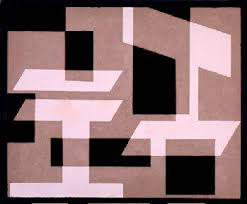 |
| 1947
He lived in Japan from 1935-1938, studying the culture,ran a Japanese art gallery in Boston, learned Japanese in Hawai'i and served as a translator in World War II. Self-taught, he was inspired by the monk Sesshū (snow boat) Tōyō (1420-1506), a famous Zen painter fascinated with the concept of the "marvelous void."
He began painting the 1930's and quickly turned to hard-edge geometric minimal abstraction.
He wrote: "With respect to my direct influences I must stress my interest in 15th and 16th century Japanese painters. I have found comfort in some aspects of thought expressed by Malevitch, and I am indebted to Mondrian because his painting strongly indicated that the natural extension of Neo-Plasticism is the totally abstract."[4] (Wikipedia entry)
|
 |
| 1948 |
"Barrier: to get through it,
follow the pathless path".
"My purpose is to achieve the totally abstract. I want to communicate only to the extent that the painting will serve to induce or intensify the viewer's natural desire for contemplation without benefit of a guiding principle. I must therefore free the viewer from the demands or special qualities imposed by the particular by omitting the image (object). This I manage by the use of neutral forms." (Wikipedia entry)
Several artists discuss McLaughlin in a video; to me the seem to muddle around, finding few words to help attend to McLaughlin's work. "So close to perfect"...he had a really good journey...a rigorous spiritual practice...paintings are about the figure/ground relationship...more organic than mechanical...(Grotjan examining the non-mechanical quality of the edges, lines, and color planes).
The lovely chairs placed in perfect relation to the paintings were crafted by Roy McMakin, and each is slightly different, and merit another walk through the rooms to view them and the paintings in relation. And how very pleasing it is to do this. Discovering how each differs and how the quality of this difference refers and is generated by each painting is purely fun, and nodding, of course, this is just right, perfect, at each one.

































No comments:
Post a Comment